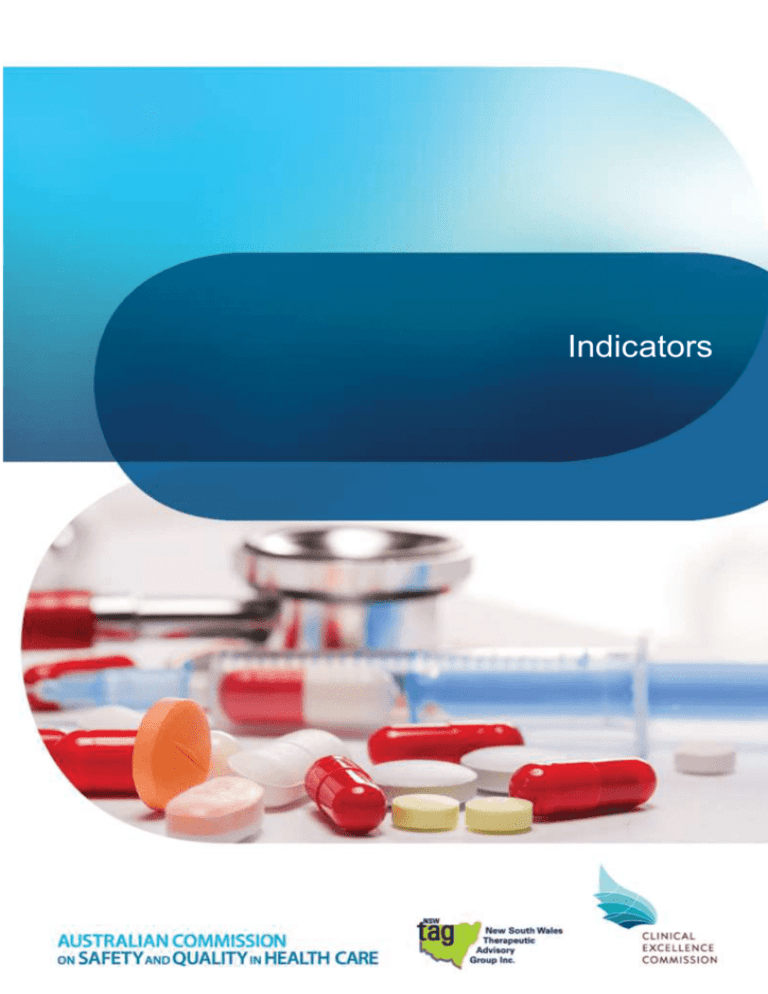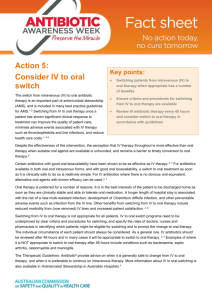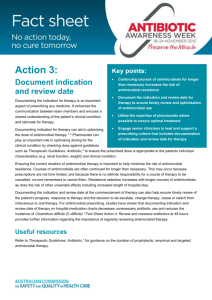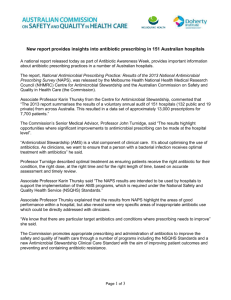MS_Word
advertisement

Indicators Antibiotic therapy QUM domains: Appropriate choice Safe and effective use 2.2 Percentage of prescriptions for restricted antibiotics that are concordant with drug and therapeutics committee approved criteria Purpose This indicator addresses effectiveness of processes for preventing emergence of multiresistant organisms. Background and evidence Multidrug resistance in common clinical pathogens is a growing problem and widespread and indiscriminate use of broad spectrum anti-infectives is a major contributor. 1 Unnecessary use of antimicrobials as well as inappropriate choice, dose and duration of therapy drive selection of resistant bacteria. 2 Restricting use of certain antibiotics to defined groups of patients and using narrow spectrum antibiotics wherever possible can slow or constrain the emergence of antibiotic resistance and prolong the effectiveness of existing antibiotics. 1,2 Treatment should be based on knowledge of local patterns of likely pathogens and local susceptibility data.1 Medicines that remain the last defence against multi-resistant strains should only be used under expert direction.1 Antimicrobial stewardship (AMS) programs have been developed in response to these issues. AMS is a systematic approach to optimising the use of antimicrobials. As a key quality and public health strategy for each hospital executive, AMS is used to reduce inappropriate antimicrobial use, improve patient outcomes and reduce adverse consequences of antimicrobial use. 3 A multidisciplinary AMS committee is charged with liaising closely with several different hospital quality committees, most importantly the drug and therapeutics committee (DTC) with which an antimicrobial prescribing and management policy should be established. This should incorporate an antimicrobial formulary with clear guidelines for antimicrobial treatment and prophylaxis. Policies and guidelines should be consistent with the current edition of Therapeutic Guidelines: Antibiotic 2 as a minimum standard, although DTCs may choose to impose tighter restrictions in alignment with local resistance patterns. The DTC will establish specified antimicrobial agents which may only be prescribed under restricted conditions. Prospective approval of the AMS team or an infectious dise ases clinician may be required for certain agents per treatment episode. Antimicrobial usage audits should be used to monitor appropriate prescribing of antibiotics. Regular audit and feedback has been shown to contribute to improved compliance with restri cted antibiotic policies. 2 To ensure universal relevance of this indicator and attainment of a reasonable sample size in health facilities of all sizes and areas, its scope has been limited to the antibiotic group of antimicrobials. Key definitions Antimicrobial stewardship is an ongoing effort by a healthcare institution to optimise antimicrobial use among hospital patients in order to improve patient outcomes, ensure cost -effective therapy and reduce adverse sequelae of antimicrobial use (including antimicrobial resistance). 3 National Quality Use of Medicines Indicators for Australian Hospitals 2014 2 Restricted antibiotics refers to those antibiotics that could contribute to development of multi -resistant organisms including parenteral and/or oral formulations of the following antibiotics: 4 Aminoglycosides: amikacin, gentamicin (after 48 hours of use) Carbapenems: doripenem, ertapenem, imipenem, meropenem Cephalosporins: cefotaxime, ceftriaxone, cefepime, ceftazidime, cefpirome, ceftaroline Glycopeptides: vancomycin, teicoplanin Macrolides: azithromycin, clarithromycin Quinolones: ciprofloxacin, moxifloxacin, norfloxacin Others: aztreonam, colistin, daptomycin, linezolid, sodium fusidate, tigecycline, rifampicin. Other antibiotics may be included in the audit according to locally agreed antibiotic restrictions. As new antibiotic s are introduced into the Australian market, they should be considered for inclusion in this list if they pose a risk for emergence of multi-resistant organisms. Data collection for local use Please refer to the section Using the National Quality Use of Medicines Indicators for Australian Hospitals for guidance on sample selection, sample size, measurement frequency and other considerations. Inclusion criteria: All adult, paediatric and neonatal patients prescribed a restricted antibiotic (including those in critical care units such as intensive care, transplant and surgical units). Exclusion criteria: Nil. Recommended data sources: Medical records and medication charts. The data collection tool for QUM Indicator 2.2 assists data collection and indicator ca lculation. Data collection for inter-hospital comparison This indicator may be suitable for inter-hospital comparison. In this case, definitions, sampling methods and guidelines for audit and reporting need to be agreed in advance in consultation with the coordinating agency. Indicator calculation Numerator = Number of prescriptions for restricted antibiotics that are concordant with DTC approved criteria Denominator = Number of prescriptions for restricted antibiotics in sample Limitations and interpretation At times antibiotics may not be prescribed in accordance with DTC criteria, but may nevertheless be approved by microbiology/infectious diseases departments. Where this is explicitly documented it can be considered a concordant prescription. In the absence of documentation regarding specific approval, it should be assumed that antibiotic prescription is not concordant. National Quality Use of Medicines Indicators for Australian Hospitals 2014 3 Further information Electronic prescribing systems with decision support and purpose -designed electronic AMS applications can be used to help manage approval processes for use of restricted antibiotics. For further information regarding formulary restrictions and antimicrobial approval systems refer to Australian Commission on Safety and Quality in Health Care publication, Antimicrobial Stewardship in Australian Hospitals 2011 3 http://www.safetyandquality.gov.au/our-work/healthcare-associated-infection/antimicrobial-stewardship/book/ The Australian Commission on Safety and Quality in Health Care and NPS MedicineWise have developed a series of e-learning modules on antimicrobial prescribing. The modules address specific areas where antimicrobial use in hospitals is suboptimal. The modules can be accessed at http://learn.nps.org.au Medication Safety Self Assessment for Australian Hospitals 5 (MSSA) can help identify potential strategies for improvement with this and other indicators. The MSSA encourages development of robust systems for safe prescribing, dispensing, administration and monitoring of medicines. The MSSA is available at www.cec.health.nsw.gov.au This indicator can be used to assist hospitals in meeting the National Safety and Quality Health Service Standard 1 [items 1.2.1, 1.2.2, 1.5.2, 1.6.1, 1.6.2, 1.7.2], Standard 3 [items 3.1.1, 3.1.2, 3.4.1, 3.4.2, 3.4.3, 3.14.1, 3.14.3, 3.14.4 ] and Standard 4 [items 4.1.1, 4.2.1, 4.2.2, 4.3.2, 4.3.3, 4.5.1, 4.5.2]. 6 References 1. Australian Medicines Handbook. Australian Medicines Handbook Pty Ltd, 2012. 2. eTG complete [Internet]. Melbourne: Therapeutic Guidelines Limited; 2010 March. 3. Duguid M and Cruickshank M, eds. Antimicrobial stewardship in Australian Hospitals. Australian Commission on Safety and Quality in Health Care, Sydney, 2011. 4. List of Recommended Antimicrobial Restrictions. QUAH Antimicrobial Stewardship Toolkit. Clinical Excellence Commission 2013. www.cec.health.nsw.gov.au/programs/quah (Accessed 19 September 2014). 5. Medication Safety Self Assessment for Australian Hospitals: Institute for Safe Medication Practices USA (Adapted for Australian use by NSW Therapeutic Advisory Group and the Clinical Excellence Commission), 2007. 6. Australian Commission on Safety and Quality in Health Care. National Safety and Quality Health Service Standards, Sydney, ACSQHC, 2012. National Quality Use of Medicines Indicators for Australian Hospitals 2014 4






